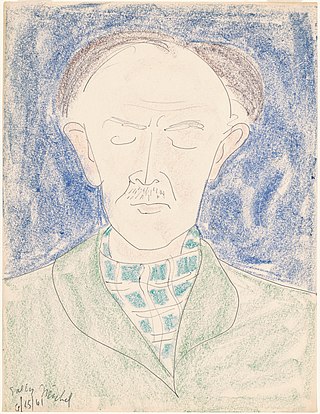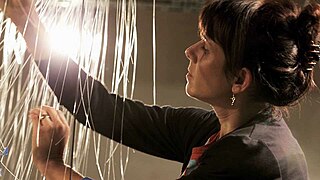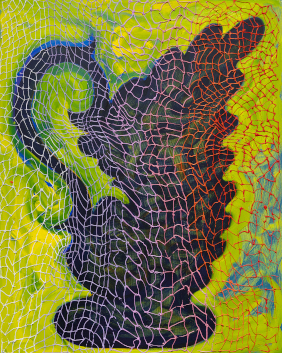Related Research Articles

Georgia Totto O'Keeffe was an American modernist painter and draftswoman whose career spanned seven decades and whose work remained largely independent of major art movements. Called the "Mother of American modernism", O'Keeffe gained international recognition for her meticulous paintings of natural forms, particularly flowers and desert-inspired landscapes, which were often drawn from and related to places and environments in which she lived.

Milton Clark Avery was an American modern painter. Born in Altmar, New York, he moved to Connecticut in 1898 and later to New York City. He was the husband of artist Sally Michel Avery and the father of artist March Avery.

The San Antonio River Walk is a city park and special-case pedestrian street in San Antonio, Texas, one level down from the automobile street. The River Walk winds and loops under bridges as two parallel sidewalks lined with restaurants and shops, connecting the major tourist draws such as the Shops at Rivercenter, the Arneson River Theatre, Marriage Island, La Villita, HemisFair Park, the Tower Life Building, the San Antonio Museum of Art, the Pearl, and the city's five Spanish colonial missions, which have been named a World Heritage Site, which includes the Alamo. During the annual springtime Fiesta San Antonio, the River Parade features flowery floats that float down the river.
Dixie Friend Gay is a U.S. visual artist who works in a variety of media and is noted for work exploring the power of nature, particularly public art.

Millard Owen Sheets was an American artist, teacher, and architectural designer. He was one of the earliest of the California Scene Painting artists and helped define the art movement. Many of his large-scale building-mounted mosaics from the mid-20th century are still extant in Southern California. His paintings are in the Metropolitan Museum of Art and the Whitney Museum in New York, the Chicago Art Institute, the National Gallery in Washington D.C.; and the Los Angeles County Museum.
César Augusto Martínez is an artist, prominent in the field of Chicano art. While studying at what was then called Texas A&I College, he became involved in the Chicano movement for civil rights. He subsequently befriended several of its leaders.

The culture of San Antonio reflects the history and culture of one of the state's oldest and largest cities straddling the regional and cultural divide between South and Central Texas. Historically, San Antonio culture comes from a blend of Central Texas and South Texas (Southwestern) culture. Founded as a Spanish outpost and the first civil settlement in Texas, San Antonio is heavily influenced by Mexican American culture due to Texas formerly being part of Mexico and, previously, the Spanish Empire. The city also has significant German, Anglo, and African American cultural influences. San Antonio offers a host of cultural institutions, events, restaurants and nightlife in South Texas for both residents and visitors alike.
Lowell Blair Nesbitt was an American painter, draughtsman, printmaker, and sculptor. He served as the official artist for the NASA Apollo 9, and Apollo 13 space missions; in 1976 the United States Navy commissioned him to paint a mural in the administration building on Treasure Island spanning 26 feet x 251 feet, then the largest mural in the United States; and in 1980 the United States Postal Service honored Lowell Nesbitt by issuing four postage stamps depicting his paintings.

Patricia Johanson is an American artist. Johanson is known for her large-scale art projects that create aesthetic and practical habitats for humans and wildlife. She designs her functional art projects, created with and in the natural landscape, to solve infrastructure and environmental problems, but also to reconnect city-dwellers with nature and with the history of a place. These project designs date from 1969, making her a pioneer in the field of ecological-art Johanson's work has also been classified as Land Art, Environmental Art, Site-specific Art and Garden Art. Her early paintings and sculptures are part of Minimalism.
Mags Harries and Lajos Héder are artists working collaboratively to create public art across the United States from their studio.
The Museo Alameda was the largest Latino museum in the United States and the first formal Smithsonian affiliate outside of Washington D.C., located in the historic Market Square in Downtown San Antonio, Texas.
May Sun is a Los Angeles–based artist known primarily for her public art projects. Sun works in the mediums of sculpture, mixed media, photography and installation. Her work has been exhibited nationally and internationally. She was born in Shanghai, China, moved to Hong Kong at the age of two with her family and immigrated to the United States in 1971 to attend the University of San Diego. "May Sun often refers to aspects of her Chinese heritage in her work, which consistently crosses cultural and political boundaries as well as the boundaries traditionally separating art forms and disciplines."
Paulina Constancia is a Filipino-Canadian artist known for her work on canvas, textiles, and found materials, sometimes incorporating stitching. She is associated with the Paulina Constancia Museum of Naïve art (MoNA). Constancia's art has been exhibited worldwide, including in countries like the Philippines, Indonesia, Thailand, Malaysia, the Netherlands, Mexico, Greece, Slovenia, and Poland. She has also displayed her art in various cities in the U.S. and Canada.
Phil Hardberger Park is a public city park of San Antonio, Texas which opened in May 2010.
Norie Sato is an artist living in Seattle, Washington. She works in the field of public art using sculpture and various media–including glass, terrazzo, plastic film, stone, and metal–and often incorporating lighting effects, landscaping, mosaics, prints, and video. She frequently collaborates with architects, city planners, and other artists and specializes in integrating artwork and site specific design.

E.V. Day is an American, New York-based installation artist and sculptor. Day's work explores themes of feminism and sexuality, while employing various suspension techniques and reflecting upon popular culture.
Margarita Cabrera is a Mexican-American artist and activist. As an artist, the objects and activities she produces address issues related to border relations, labor practices and immigration. Her practice spans smaller textile-based soft sculptures to large community-involved public artworks. In 2012 she was a recipient of the Knight Artist in Residence at the McColl Center for Visual Art in Charlotte, North Carolina. Cabrera was also a recipient of the Joan Mitchell Foundation Grant.

Wendy Edwards is an American artist known for vibrant, tactile paintings rooted in organic forms and landscape, which have ranged from representation and figuration to free-form abstraction. Her work has been strongly influenced by the 1970s Pattern and Decoration movement and its embrace of ornamentation, repetition, edge-to-edge composition, sensuality and a feminist vision grounded in women's life experience. Critics note in Edwards's paintings an emphasis on surfaces and the materiality of paint, a rhythmic use of linear or geometric elements, and an intuitive orientation toward action, response and immediacy rather than premeditation. In a 2020 review, Boston Globe critic Cate McQuaid wrote, "Edwards's pieces are exuberant, edgy, and thoughtful ... [her] sweet, tart colors and delicious textures make the senses a gateway into larger notions about women and men, creation and mortality."
References
- 1 2 3 4 5 6 7 "Featured Artist | Leticia Huerta". Fort Worth Public Art. Retrieved December 1, 2022.
- 1 2 3 4 McBride, Dana (Spring 2022). "The Serie Print Project". Contemporary Impressions the Journal of the American Print Alliance. 10 (1): 26 – via UCLA Arts Library.
- 1 2 Martin, Deborah (November 3, 2020). "San Antonio artist's giant flowers will bloom in parks across the city". San Antonio Express-News. Retrieved December 2, 2022.
- 1 2 3 4 "Public Artist Leticia Huerta Continues to Flourish Across City Parks". San Antonio Sentinel - News, Politics, Business, Lifestyle. Retrieved December 2, 2022.
- 1 2 "Downtown San Antonio "Blooms" with the Department of Arts & Culture's Latest Botanical-Inspired Public Art Series". The City of San Antonio – Official City Website. Retrieved December 1, 2022.
- ↑ Martin, Deborah (December 6, 2019). "Public art planned for locations across San Antonio will be unveiled at open-air gallery downtown". San Antonio Express-News. Retrieved December 2, 2022.
- 1 2 3 4 "Bloom Exhibit Continues to Flourish Through the City, Includes River Walk Addition". San Antonio Sentinel - News, Politics, Business, Lifestyle. Retrieved December 2, 2022.
- 1 2 "leticia-huerta". City of Charlotte Government. Retrieved December 1, 2022.
- 1 2 3 "Phoenix Office of Arts and Culture Isaac Bridge". www.phoenix.gov. Retrieved December 1, 2022.
- ↑ "Leticia Huerta, Artist Works". University of Texas at San Antonio. Retrieved December 3, 2022.
- ↑ "Leticia V. Huerta (American, b.1954)". McNay Museum. Retrieved December 3, 2022.